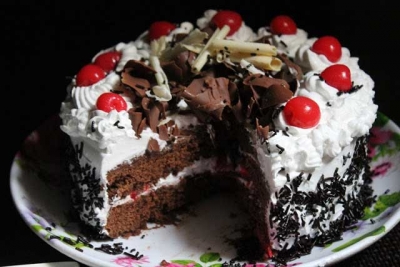
The Black Forest cake is so called because it originated in the Black Forest region in Germany. The cake topped with shavings of chocolate and cherries is made up of layers of chocolate sponge cake, whipped cream and sour cherry brandy of the region.
Typically, Black Forest gateau consists of several layers of chocolate sponge cake sandwiched with whipped cream and cherries. It is decorated with additional whipped cream, maraschino cherries, and chocolate shavings. In some European traditions, sour cherries are used both between the layers and for decorating the top. Traditionally, kirschwasser, a clear spirit made from sour cherries, is added to the cake. Other spirits are sometimes used, such as rum, which is common in Austrian recipes. German law mandates that any dessert labeled Schwarzwälder Kirschtorte must have kirschwasser.
The dessert is not directly named after the Black Forest mountain range in southwestern Germany.
According to one school of thought, the name is derived from the specialty liquor of that region, known as Schwarzwälder Kirsch(wasser), which is distilled from tart cherries. This is the ingredient that gives the dessert its distinctive cherry pit flavor and alcoholic content flavor.
Some sources claim that the name of the cake is inspired by the traditional costume of the women of the Black Forest region, with a characteristic hat with big, red pom-poms on top, called Bollenhut.
The confectioner Josef Keller [de] (1887–1981) claimed to have invented Schwarzwälder Kirschtorte in its present form in 1915 at the prominent Café Agner in Bad Godesberg, now a suburb of Bonn about 500 km (310 mi) north of the Black Forest. This claim, however, has never been substantiated. A long time ago, cherries, cream, and Kirschwasser were combined in the form of a dessert in which cooked cherries were served with cream and Kirschwasser, originated in Black forest region famous for its cherry trees.
Schwarzwälder Kirschtorte was first mentioned in writing in 1934. At the time it was particularly associated with Berlin but was also available from high-class confectioners in other German, Austrian, and Swiss cities. In 1949 it took 13th place in a list of best-known German cakes.
Credit : Wikipedia
Picture Credit : Google




